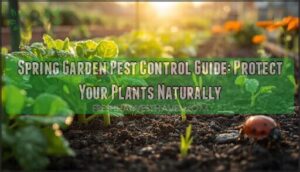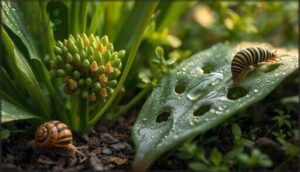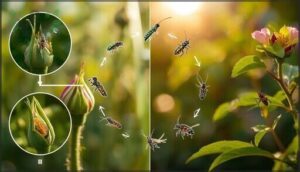This site is supported by our readers. We may earn a commission, at no cost to you, if you purchase through links.
Your spring garden wakes up hungry—and so do the pests. Those tender seedlings you’ve nurtured through late winter become prime targets the moment temperatures climb above 50°F. Aphids multiply by the hundreds in a week, flea beetles riddle leaves with holes overnight, and slugs can decimate an entire row of lettuce before you finish your morning coffee.
The difference between a thriving garden and a disappointing one often comes down to the first four weeks of spring, when pest populations establish their foothold. Understanding which pests emerge when—and how to stop them without harsh chemicals—gives you the upper hand.
The right timing, combined with strategic prevention and organic methods, protects your plants while keeping your soil and beneficial insects healthy.
Table Of Contents
- Key Takeaways
- Identifying Common Spring Garden Pests
- Timing Pest Control With Life Cycles
- Preventing Pest Infestations in Spring
- Organic and Eco-Friendly Pest Control Methods
- Ongoing Monitoring and Garden Management
- Frequently Asked Questions (FAQs)
- Is spring a good time for pest control?
- What insects should you watch for in spring?
- Is spring cleaning a sign of a pest problem?
- How do I control pests in my garden?
- What are the most common garden pests?
- Are garden pests a problem?
- How can I reduce my spring pest population?
- Why should you watch out for spring pests & diseases?
- How do I get rid of garden pests?
- How can I protect my home and garden from pests?
- Conclusion
Key Takeaways
- Spring pest control succeeds when you act during the first four weeks of warm weather—before aphids, flea beetles, and slugs establish populations that multiply exponentially.
- Timing interventions with pest life cycles (targeting larvae at 65-80°F for aphids, post-rain periods for slugs, and May leaf expansion for caterpillars) delivers maximum control with minimum effort.
- Prevention through crop rotation, row covers, disease-resistant varieties, and spring debris removal cuts pest problems by 70-80% without chemicals.
- Integrated pest management combining beneficial insects, organic treatments (neem oil, diatomaceous earth), weekly inspections, and garden journaling creates self-regulating ecosystems that reduce pesticide dependency by 30%.
Identifying Common Spring Garden Pests
As temperatures warm and your garden springs to life, so do the insects and animals that threaten your hard work. Knowing which pests to watch for—and how to spot them early—gives you the upper hand in protecting your plants.
Here are the most common culprits you’ll encounter in spring gardens and the telltale signs they leave behind.
Aphids, Slugs, Snails, and Caterpillars
Spring garden pests arrive as temperatures climb. You’ll recognize aphids by their tiny size—about one-tenth of an inch—in green, yellow, pink, black, or brown. These sap-suckers cluster on new growth, often transmitting plant viruses. Aphids are known to be pear shaped.
Slugs and snails feed during cool, moist conditions:
- Leave silvery slime trails on plants
- Create irregular holes with smooth edges
- Hide under mulch and leaf litter
Caterpillars consume entire leaves overnight, making early detection essential.
Flea Beetles, Spider Mites, and Rodents
Flea beetles jump like tiny acrobats when disturbed, leaving behind characteristic “shot hole” damage on radishes, broccoli, and tomatoes. Spider mite webbing appears on leaf undersides—your first warning sign—accompanied by yellow stippling that weakens plants quickly. Rodents tunnel through garden beds, causing crop losses that can reach 30% by consuming seeds, roots, and young seedlings.
IPM strategies target these spring garden pests effectively through natural pest control methods. Effective garden pest control requires a thorough approach to prevent damage.
Recognizing Pest Damage and Signs of Infestation
Once you recognize pest damage patterns, you’ll act faster to save your plants. Look for chewing holes in leaves—large from caterpillars, tiny from flea beetles.
Leaf discoloration like yellow speckles signals spider mites, while sticky honeydew residue marks aphid activity.
Plant deformities, including puckered or twisted leaves, confirm infestation signs requiring immediate garden pest identification and intervention.
Timing Pest Control With Life Cycles
Successful pest control isn’t just about what you use—it’s about when you act. Every garden pest moves through distinct life stages, and each stage offers a different window for intervention.
Understanding these cycles helps you strike at the right moment, when pests are most vulnerable and your efforts will have the greatest impact.
Understanding Pest Development Stages
Understanding pest life cycles gives you the upper hand in protecting your garden. Most insects move through four stages: egg, larval development, pupal transformation, and adult emergence. Larvae cause the most damage since they’re actively feeding.
Integrated pest management works best when you time natural pest control methods with these stages. Identifying beneficial insects helps you avoid harming garden allies while targeting true pests.
Best Intervention Times for Key Pests
When temperatures hit 65°-80°F, aphid intervention timing becomes critical—treat early spring populations before they explode. Slug control windows open after spring rains when moisture drives activity. Time caterpillar spray timing to May’s leaf expansion for maximum Btk effectiveness. Watch for flea beetle emergence when redbuds bloom, and target spider mite control in cool spring conditions.
Pest forecasting through pest monitoring of these spring garden pests, combined with understanding pest life cycles and pest identification, helps you strike at vulnerable stages.
Monitoring Pest Emergence in Early Spring
Track pest monitoring signals before damage strikes. Visual inspections reveal early pest signs like aphid clusters on new growth and slug slime trails.
Degree day models predict emergence timing—eastern tent caterpillars hatch near 62 GDD, while spider mites activate around 275 GDD. Weather impact matters: warm, wet springs accelerate spring garden pests.
Deploy sticky traps and shelter traps for identifying spring garden pests during critical spring garden pest prevention windows.
Preventing Pest Infestations in Spring
Prevention is always easier than treatment for garden pests. By taking a few strategic steps before pests arrive, you can protect your plants without reaching for harsh chemicals.
Here are four proven methods to keep your spring garden healthy and pest-free from the start.
Garden Cleanliness and Debris Removal
Spring garden cleanup is your first line of defense against overwintering pests and disease prevention. Removing plant debris when daytime temperatures stay above 50°F for seven days protects beneficial habitats while cutting pest populations by 70-80%. Leave 6-8 inches of dead stems so cavity-nesting insects can emerge safely.
| Garden Hygiene Task | Pest Control Impact |
|---|---|
| Remove fallen leaves and debris | Reduces fungal spores and larvae by 70%+ |
| Cut back dead stems to 6-8 inches | Protects beneficial insects while limiting pest shelter |
| Dispose diseased material (don’t compost) | Prevents disease spread in spring garden |
| Clear non-decomposable items | Eliminates hidden overwintering sites |
Proper sanitation timing and preventive measures make all the difference. Composting risks introducing pathogens back into your beds, so trash or burn diseased plants instead. Clean garden debris now, and you’ll spend less time fighting pests later.
Crop Rotation and Companion Planting
Rotating crops by plant family disrupts pest cycles, slashing soil-borne populations by up to 80%. Move your Brassicas, legumes, and nightshades through 3-4 year cycles to starve overwintering larvae.
Companion planting adds another layer—basil near tomatoes, nasturtiums as trap crops for aphids.
This integrated pest management approach builds soil fertility, boosts plant diversity, and creates ecosystem balance without chemicals.
Using Row Covers and Physical Barriers
Think of row covers as your first line of defense—a physical shield that stops pests before they reach your plants. Floating row covers made from UV-stabilized polyester reduce insect attacks by up to 80% when properly installed.
Secure edges with soil or stakes, use hoops to prevent plant contact, and you’ll create beneficial garden microclimates while achieving effective pest exclusion without chemicals.
Selecting Disease-Resistant Plant Varieties
Choosing varieties bred for disease resistance is like hiring a built-in security team for your garden ecosystem. These plants carry genetic traits from plant breeding programs that recognize and fight pathogens before damage spreads, cutting disease incidence by up to 50% and slashing pesticide needs in half.
- Resistant tomatoes and squash defend against powdery mildew and blight naturally
- Disease-coded seed catalogs guide your crop variety selections for organic gardening success
- Pathogen management improves when neighbors plant resistant varieties too
- Stronger plant health means better pest resistance and higher yields year-round
Organic and Eco-Friendly Pest Control Methods
Once you’ve spotted pests in your spring garden, you’ll want solutions that work without harming the ecosystem you’re building. Organic methods target specific problems while protecting beneficial insects, soil health, and the plants themselves.
Here are four proven approaches that keep your garden thriving naturally.
Insecticidal Soaps and Neem Oil Applications
For effective natural pest control, apply insecticidal soap at a 4% soap concentration targeting aphids, whiteflies, and spider mites. Mix neem oil at 1-2 fluid ounces per gallon, spraying every 7-14 days using thorough spray techniques that coat leaf undersides.
Both organic pest control methods require direct contact with pests. Check for OMRI organic certification on product labels to prevent pest resistance while protecting beneficial insects.
Diatomaceous Earth and Natural Traps
Food-grade diatomaceous earth kills hard-bodied pests like flea beetles and ants with 86-100% mortality rates when applied at 2.5-25 g/m² in dry conditions. Dust DE on leaf surfaces and soil, but reapply after rain since moisture reduces effectiveness.
Natural trap plants like nasturtiums (Tropaeolum majus) draw aphids away from your main crops, concentrating pests for targeted removal while attracting beneficial predators.
Introducing Beneficial Insects and Nematodes
Beyond passive traps, you can deploy living allies to wage war on pests. Beneficial insect release introduces predators like Coccinella septempunctata (seven-spotted lady beetles) and Chrysoperla spp. (lacewings) directly into your garden. Nematode applications target soil-dwelling grubs with microscopic hunters—Steinernema feltiae thrives at 55-85°F.
This biological control forms the backbone of integrated pest management:
- Release 1,000-2,000 beneficial insects per 1,000 square feet at dusk
- Apply 100 million nematodes per 2,000 square feet in moist soil
- Create habitat with early bloomers like dill and cilantro for natural pest control
Your garden becomes a self-regulating system through pest suppression methods that reduce chemical dependence while maintaining organic pest control standards.
Hand-Picking and Pruning Infested Plants
When biological allies won’t reach every pest, manual control steps in. You can handpick larger pests like tomato hornworms (Manduca quinquemaculata) at dawn when they’re sluggish—drop them into soapy water for immediate pest removal.
For infested pruning, cut 6 inches below visible damage and sanitize shears between cuts. This garden sanitation accelerates plant recovery while maintaining organic pest control standards without chemical intervention.
Ongoing Monitoring and Garden Management
Winning the battle against spring pests doesn’t end once you’ve applied your first round of controls. Your garden needs consistent attention throughout the season to catch new problems before they spiral out of control.
Here’s how to stay one step ahead with smart monitoring and management practices that keep your plants thriving all spring long.
Regular Plant Inspections and Early Detection
You can’t protect what you don’t inspect. Regular plant inspections give you early warning signs before pest infestations spiral out of control.
Walk through your garden weekly, checking leaf undersides, stems, and soil surfaces for visual clues—nibbled leaves, sticky residues, or slime trails. These detection methods let you identify problems when they’re still manageable.
Catching aphids or slugs early protects plant health and saves you money on costly interventions later.
Keeping a Garden Journal for Pest Tracking
Recording pest encounters transforms guesswork into data-driven gardening. Your garden journal tracks pest identification, damage severity, and treatment effectiveness over time—creating historical pest records that reveal patterns you’d otherwise miss.
Document these details:
- Pest species (Myzus persicae for green peach aphids)
- First sighting dates and weather conditions
- Control methods applied and application rates
- Results within 7-14 days
- Crop locations for pest trend analysis
Journaling technology like mobile apps makes real-time tracking simple, reducing pesticide use by 30% through targeted pest prevention and improved garden maintenance timing.
Adjusting Control Strategies as Needed
When do you shift tactics in pest control? When your journal reveals diminishing method effectiveness or pest resistance developing, it’s time to pivot. Integrated pest management demands flexibility—rotating organic pest control approaches, introducing different natural pest control tools, and reallocating resources toward prevention rather than reaction. Evolving conditions require evolving strategies.
| Control Strategy | Adjustment Trigger |
|---|---|
| Neem oil/insecticidal soap | Pest populations unchanged after 2 applications |
| Beneficial insect release | Pest resurgence within 3-4 weeks |
| Physical barriers | Damage appearing under covers |
| Hand-picking frequency | Infestation levels doubling weekly |
| Treatment timing | Pest emergence shifting earlier/later |
IPM adaptation keeps you ahead of pests, not chasing them.
Maintaining Soil Health and Biodiversity
Think of healthy soil as your garden’s immune system. The Soil Food Web—earthworms, mycorrhizal fungi, bacteria—drives Nutrient Cycling that feeds plants and strengthens Pest Resistance. Organic Amendments like compost boost biodiversity while improving Water Retention.
Healthy soil is your garden’s immune system, where earthworms, fungi, and bacteria strengthen pest resistance and feed your plants
Regular soil testing confirms pH stays between 6.0-7.0. A thriving garden ecosystem with diverse beneficial insects starts beneath your feet, where soil health determines everything above ground.
Frequently Asked Questions (FAQs)
Is spring a good time for pest control?
Yes, spring is ideal for pest control. Early intervention targets pests during vulnerable life stages, preventing population explosions.
You’ll reduce damage, lower treatment costs, and minimize health risks while supporting environmental balance in your garden.
What insects should you watch for in spring?
Watch for aphids clustering on new growth with sticky honeydew, flea beetles creating shot holes, caterpillars chewing leaves, spider mites spinning fine webs, and slugs leaving slime trails on your spring garden pests.
Is spring cleaning a sign of a pest problem?
Spring cleaning uncovers hidden pest signs like droppings and nests, revealing existing infestations.
Cleaning reveals pests by removing debris and moisture that attracts them, offering critical pest-proofing benefits through life cycle disruption and improved garden hygiene.
How do I control pests in my garden?
You’ll control garden pests most effectively by combining preventative garden care with biological controls, manual pest removal, and organic pest control methods like neem oil—timing interventions with pest life cycles for maximum impact.
What are the most common garden pests?
Aphids, slugs, flea beetles, and spider mites top the list in most gardens. You’ll also encounter caterpillars, snails, and occasionally rodents—each leaving distinctive damage patterns that help with garden pest identification and understanding pest behavior.
Are garden pests a problem?
Yes. Garden pests cause significant crop yield loss—up to 40% of global production annually—and economic impact exceeding $220 billion.
Effective pest control and organic pest prevention reduce these losses dramatically while protecting your investment.
How can I reduce my spring pest population?
Wondering how to stop pests before they multiply? You’ll reduce spring pests by choosing resistant varieties, improving soil health, adjusting watering practices, introducing beneficial insects, using trap cropping, and releasing natural predators for organic pest control and prevention.
Why should you watch out for spring pests & diseases?
Spring pests and diseases can stunt your plants and slash yields by up to 30%, while also triggering costly infestations.
Early detection is key to protecting your garden’s health and biodiversity, and it can save you money on emergency treatments later.
How do I get rid of garden pests?
You can eliminate garden pests using organic pest control methods like insecticidal soaps and neem oil, natural predators such as beneficial insects, companion plants, pest traps, and biological controls alongside hand-picking for immediate results.
How can I protect my home and garden from pests?
Protect your garden with integrated pest management: combine garden sanitation practices, eco-friendly repellents, and home pest barriers.
Natural pest control using beneficial insects works alongside organic pest control methods.
Professional pest control offers additional support when needed.
Conclusion
Protecting plants from pests starts with patience and preparation. Your spring garden pest control guide becomes second nature once you master the rhythm of emergence, the timing of intervention, and the power of prevention.
Watch closely, act early, and trust the balance you’re building—beneficial insects, healthy soil, and strategic barriers working together.
The garden that survives spring’s hungry visitors doesn’t fight harder; it fights smarter, turning observation into action before damage takes root.











